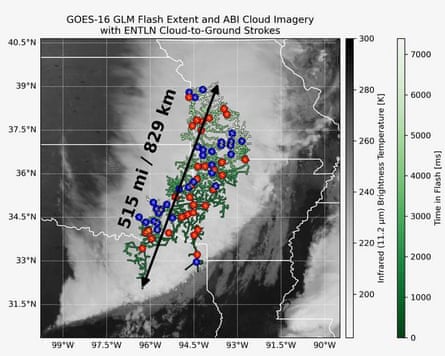
A lightning flash stretching 515 miles (829 kilometres) across the skies of the United States has been confirmed as the longest ever recorded, according to the World Meteorological Organization (WMO).
The bolt, which lit up the Great Plains from Texas to Missouri on 22 October 2017, has now been officially recognised as the world’s longest lightning flash.
The previous record of 768km was also recorded in the Great Plains, a hotspot for severe thunderstorms, on 29 April 2020.
Since 2016, scientific advances in space-based mapping have allowed for lightning flashes to be measured over a broader space, allowing these long flashes to be recorded.
This event was one of the first flashes to be documented using the National Oceanic and Atmospheric Administration’s latest model of orbital satellite, known as a geostationary operational environmental satellite.
ALSO READ: South African police arrest 1,000 illegal miners in multi-day operation
Michael J Peterson, the lead author and an evaluation committee member of the Severe Storms Research Center at the Georgia Institute of Technology, said: “The extremes of what lightning is capable of is difficult to study because it pushes the boundaries of what we can practically observe. Adding continuous measurements from geostationary orbit was a major advance.”

Before using orbital satellites to record the duration and length of lightning flashes, data was collected by ground-based sensors. Many scientists acknowledged that there were limits to the duration and length of lightning they could record with these ground sensors.
The advances in technology have also allowed for the recording of the greatest duration for a single lightning flash. The record is a flash that lasted 17.1 seconds during a thunderstorm over Uruguay and northern Argentina on 18 June 2020.
Prof Randall Cerveny, a rapporteur of weather and climate extremes at the WMO, said: “[The] everyday implications of these events are that lightning can travel quite long distances away from the parent thunderstorm. Because of this fact, people need to limit their outdoor activities during lightning-producing thunderstorms.”
The WMO recommends that people caught in a lightning storm take shelter in substantial buildings with wiring and plumbing, or a fully enclosed metal-topped vehicle.



